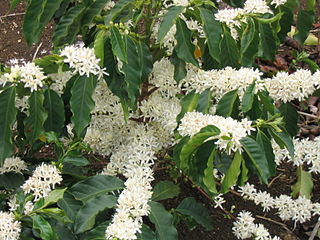
Coffea is a genus of flowering plants in the family Rubiaceae. Coffea species are shrubs or small trees native to tropical and southern Africa and tropical Asia. The seeds of some species, called coffee beans, are used to flavor various beverages and products. The fruits, like the seeds, contain a large amount of caffeine, and have a distinct sweet taste.

The Rubiaceae are a family of flowering plants, commonly known as the coffee, madder, or bedstraw family. It consists of terrestrial trees, shrubs, lianas, or herbs that are recognizable by simple, opposite leaves with interpetiolar stipules and sympetalous actinomorphic flowers. The family contains about 13,500 species in about 620 genera, which makes it the fourth-largest angiosperm family. Rubiaceae has a cosmopolitan distribution; however, the largest species diversity is concentrated in the tropics and subtropics. Economically important genera include Coffea, the source of coffee, Cinchona, the source of the antimalarial alkaloid quinine, ornamental cultivars, and historically some dye plants.

Coffee is a beverage brewed from roasted coffee beans. Darkly colored, bitter, and slightly acidic, coffee has a stimulating effect on humans, primarily due to its caffeine content. It has the highest sales in the world market for hot drinks.

Coffea arabica, also known as the Arabica coffee, is a species of flowering plant in the coffee and madder family Rubiaceae. It is believed to be the first species of coffee to have been cultivated and is currently the dominant cultivar, representing about 60% of global production. Coffee produced from the less acidic, more bitter, and more highly caffeinated robusta bean makes up most of the remaining coffee production. The natural populations of Coffea arabica are restricted to the forests of South Ethiopia and Yemen.
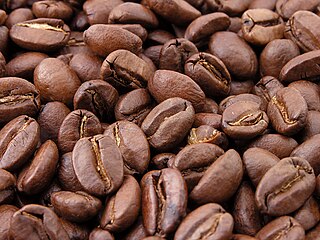
A coffee bean is a fruit from the Coffea plant and the source for coffee. It is the pip inside the red or purple fruit. This fruit is often referred to as a coffee cherry, and like the cherry, it is a stone fruit. Even though the coffee beans are not technically beans, they are referred to as such because of their resemblance to true beans. The fruits most commonly contain two stones with their flat sides together. A small percentage of cherries contain a single seed, instead of the usual two, called a "peaberry". The peaberry occurs only between 10% and 15% of the time, and it is a fairly common belief that they have more flavour than normal coffee beans. Like Brazil nuts and white rice, coffee beans consist mostly of endosperm.

Kona coffee is the market name for coffee cultivated on the slopes of Hualalai and Mauna Loa in the North and South Kona Districts of the Big Island of Hawaii. It is one of the most expensive coffees in the world. Only coffee from the Kona Districts can be described as "Kona." The weather of sunny mornings, clouds or rain in the afternoon, little wind, and mild nights combined with porous, mineral-rich volcanic soil create favorable coffee-growing conditions. The loanword for coffee in the Hawaiian language is kope, pronounced.

Coffea canephora is a species of coffee that has its origins in central and western sub-Saharan Africa. It is a species of flowering plant in the family Rubiaceae. Though widely known as Coffea robusta, the plant is scientifically identified as Coffea canephora, which has two main varieties, robusta and nganda.

Kapeng barako, also known as Barako coffee or Batangas coffee, is a coffee varietal grown in the Philippines, particularly in the provinces of Batangas and Cavite. It belongs to the species Coffea liberica. The term is also used to refer to all coffee coming from those provinces. Barako in the languages of the Philippines means "stud", and is associated with the image of masculinity. Barako has a strong flavor and fragrance reminiscent of aniseed.
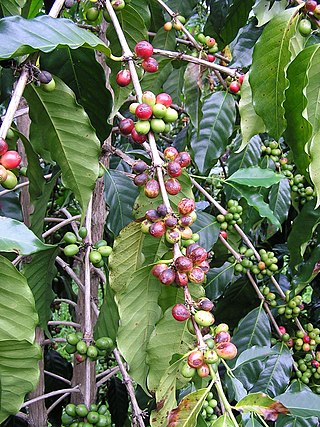
Mycosphaerella coffeicola is a sexually reproducing fungal plant pathogen. It is most commonly referred to as the asexual organism Cercospora coffeicola.
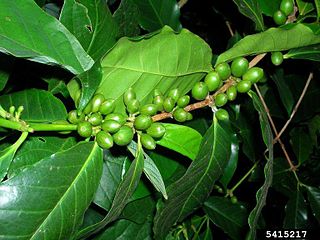
Colletotrichum kahawae is a fungal plant pathogen that causes coffee berry disease (CBD) on Coffea arabica crops. The pathogen is an ascomycete that reproduces asexually. The asexual spores (conidia) are stored within acervuli. This disease is considered to be one of the major factors hampering C.arabica production in the African continent, which represents the current geographic range of the fungus. Coffee berry disease causes dark necrosis in spots and causes the green berries of the coffee to drop prematurely. High humidity, relatively warm temperatures, and high altitude are ideal for disease formation. Given the severity of the disease and the lack of effective control measures, there is great concern that the fungus may spread to other coffee producing continents, such as South America, which could have catastrophic consequences.

Gardenia thunbergia is a sturdy large shrub or small tree endemic to the southern and eastern regions of South Africa and neighbouring territories such as Eswatini. It grows largely in forest or on forest margins, occurring in the Eastern Cape, Natal and Transkei in South Africa. It is densely twiggy and rigid with smooth light-grey bark, and is horticulturally valuable, being easy to grow as a strong hedge, but more usually as a specimen plant, striking in appearance and long lived. The abundant and extremely fragrant flowers are about 70 mm in diameter with long tubes only accessible to the proboscises of nocturnal hawkmoths. The leaves are smooth, shiny, whorled and entire, and clustered at the ends of branchlets. The fruit is oval, hard, woody and fibrous, about 80 mm long and about 40 mm in diameter, light grey with small raised white spots and if not eaten by large browsers or elephant, will remain on the tree for years. Its common names include forest gardenia, mutarara, tree gardenia, white gardenia and wild gardenia. In Afrikaans it is variously known as buffelsbol, stompdoring, or wildekatjiepiering.

Coffea liberica, commonly known as the Liberian coffee, is a species of flowering plant in the family Rubiaceae from which coffee is produced. It is native to western and central Africa, and has become naturalised in areas including Colombia, Venezuela, the Philippines, Borneo and Java.
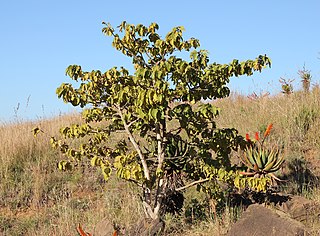
Vangueria infausta, the medlar or African medlar, is a species of plant in the family Rubiaceae, which is native to the southern and eastern Afrotropics. Some other names for V. infausta in Southern African languages include mmilo in Northern Sotho, muzwilu in Venḓa, umviyo in Southern Ndebele, mothwani in Tswana and umtulwa in Zulu.

Gesha coffee, sometimes referred to as Geisha coffee, is a variety of coffee tree that originated in the Gori Gesha forest, Ethiopia, though it is now grown in several other nations in Africa, Asia, and the Americas. It is widely known for its unique flavor profile of floral and sweet notes, its high selling price, and its exclusivity as its demand has increased over the years.
Coffea charrieriana, also known as Charrier coffee, is a species of flowering plant from the Coffea genus. It is a caffeine-free coffee plant endemic to Cameroon in Central Africa. It is the first recorded caffeine-free Coffea in Central Africa, and the second to be recorded in Africa. The first caffeine-free species was previously discovered in Kenya, named C. pseudozanguebariae. The International Institute for Species Exploration at Arizona State University and a committee of taxonomists and scientists voted C. charrieriana as one of the top 10 species described in 2008.
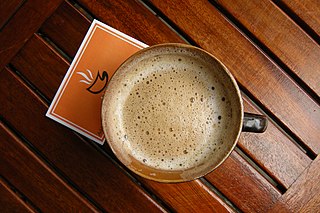
Low caffeine coffee is a term that is used by coffee producers to describe coffee that has not been subjected to a process of decaffeination, but is substantially lower in caffeine than average coffee. Samples of coffee vary widely in caffeine levels due to many factors, some well documented and some not fully understood, such as the action of soil, water levels and sunlight. Low caffeine coffees are typically created by assaying caffeine levels of different bean lots and selecting the best flavor profile from the lots that are naturally lowest in caffeine.
Keetia gueinzii is an evergreen scandent shrub in the family Rubiaceae. The species epitheton is named after Wilhelm Gueinzius, a German naturalist who collected plants in South Africa. It became the type species of Keetia after the original type species, Keetia transvaalensis, was made a synonym. This species is found down the southern African east coast in Malawi, Zimbabwe, Mozambique and South Africa.

Coffea stenophylla, also known as highland coffee or Sierra Leone coffee, is a species of Coffea originating from West Africa.
Aningeria adolfi-friederici is a species of plant in the family Sapotaceae, a tall, tropical forest tree. It is found in Burundi, the Democratic Republic of the Congo, Ethiopia, Kenya, Malawi, Rwanda, Sudan, Tanzania, Uganda, Zambia and Zimbabwe. The specific name adolfi-friedericii was given in honour of Duke Adolf Friedrich of Mecklenburg, a German explorer in Africa. Its trade name muna is taken from Gĩkũyũ mũna.

















